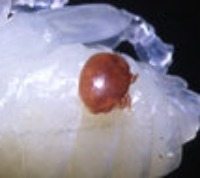Varroa Mite
Varroa is a wide spread problem affecting honey bees, and beekeepers need to be able to identify it, know how to treat it, and hopefully how to prevent an infestation. There is much information on the internet about this issue. Here is an introduction to the problem, with links to further information.
What Is Varroa?
Also known as Varroa Destructor, this is a serious threat to the honey bee colony.
Honey bee colonies can literally be wiped out as a result of infestations.
It is an external parasitic mite. They are especially known to attack two species of honey bee: Apis cerana and Apis mellifera.
Adult mites are actually visible on honey bees. As can be seen, they are a reddish-brown, oval coloured mite, around the size of a pinhead.
Below is a photograph of a mite on honey bee pupae.

What Do Varroa Mites Do?
The mites attach themselves to the body of the honey bee. They then proceed to suck the heamolymph of the bee (the bee’s body fluid, or ‘bee blood’). This of course weakens the bee – the immune system is compromised.
They may also transmit viruses to the bee, such as Deformed Wing Virus (DWV). Female mites lay their eggs in the honey bee brood cell. Around six eggs may be laid, which then feed on the bee pupa, often either killing it or causing it to be deformed. It is thought that drone (male honey bee) larvae are preferred by the mites, but they will also infest worker larvae to eventually kill the colony.
Is Varroa The Cause Of CCD?
For further information, see my page about Colony Collapse Disorder. Colony Collapse Disorder has been found to have occurred where Varroa was not present.
Check the following links for further information about honey bees:
Treating and preventing Varroa
A range of methods outlined.
Is there a link between neonicotinoids and Varroa?
Research suggests neonicotinoids may 'favour' mites in some way. Do neonicotinoids make bees more vulnerable?